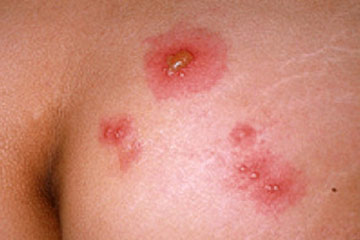Interim Guidance on Antiviral Recommendations for Patients with Confirmed
or Suspected Swine Influenza A (H1N1) Virus Infection and Close Contacts
April 28, 2009 05:00 AM ET
Objective: To provide interim guidance on the use of antiviral agents for treatment and chemoprophylaxis of swine influenza A (H1N1) virus infection. This includes patients with confirmed, probable or suspected swine influenza A (H1N1) virus infection and their close contacts.
Case Definitions for Infection with Swine Influenza A (H1N1) Virus
A confirmed case of swine influenza A (H1N1) virus infection is defined as a person with an acute febrile respiratory illness with laboratory confirmed swine influenza A (H1N1) virus infection at CDC by one or more of the following tests:
- real-time RT-PCR
- viral culture
A probable case of swine influenza A (H1N1) virus infection is defined as a person with an acute febrile respiratory illness who is:
- positive for influenza A, but negative for H1 and H3 by influenza RT-PCR, or
- positive for influenza A by an influenza rapid test or an influenza immunofluorescence assay (IFA) plus meets criteria for a suspected case
A suspected case of swine influenza A (H1N1) virus infection is defined as a person with acute febrile respiratory illness with onset
- within 7 days of close contact with a person who is a confirmed case of swine influenza A (H1N1) virus infection, or
- within 7 days of travel to community either within the United States or internationally where there are one or more confirmed swine influenza A(H1N1) cases, or
- resides in a community where there are one or more confirmed swine influenza cases.
Infectious period for a confirmed case of swine influenza A (H1N1) virus infection is defined as 1 day prior to the case’s illness onset to 7 days after onset.
Close contact is defined as: within about 6 feet of an ill person who is a confirmed or suspected case of swine influenza A (H1N1) virus infection during the case’s infectious period.
Acute respiratory illness is defined as recent onset of at least two of the following: rhinorrhea or nasal congestion, sore throat, cough (with or without fever or feverishness)
High-risk groups: A person who is at high-risk for complications of swine influenza A (H1N1) virus infection is defined as the same for seasonal influenza (see MMWR: Prevention and Control of Influenza: Recommendations of the Advisory Committee on Immunization Practices (ACIP), 2008).
Special Considerations for Children
Aspirin or aspirin-containing products (e.g. bismuth subsalicylate – Pepto Bismol) should not be administered to any confirmed or suspected ill case of swine influenza A (H1N1) virus infection aged 18 years old and younger due to the risk of Reye syndrome. For relief of fever, other anti-pyretic medications are recommended such as acetaminophen or non steroidal anti-inflammatory drugs.
Antiviral Resistance
This swine influenza A (H1N1) virus is sensitive (susceptible) to the neuraminidase inhibitor antiviral medications zanamivir and oseltamivir. It is resistant to the adamantane antiviral medications, amantadine and rimantadine.
Antiviral Treatment
Confirmed, Probable and Suspected Cases
Recommendations for use of antivirals may change as data on antiviral susceptibilities become available.
Empiric antiviral treatment should be considered for confirmed, probable or suspected cases of swine influenza A (H1N1) virus infection. Treatment of hospitalized patients and patients at higher risk for influenza complications should be prioritized. Antiviral treatment with zanamivir or oseltamivir should be initiated as soon as possible after the onset of symptoms. Evidence for benefits from treatment in studies of seasonal influenza is strongest when treatment is started within 48 hours of illness onset. However, some studies of treatment of seasonal influenza have indicated benefit, including reductions in mortality or duration of hospitalization even for patients whose treatment was started more than 48 hours after illness onset. Recommended duration of treatment is five days. Recommendations for use of antivirals may change as data on antiviral susceptibilities and effectiveness become available. Antiviral doses recommended for treatment of swine influenza A (H1N1) virus infection in adults or children 1 year of age or older are the same as those recommended for seasonal influenza (table 1). Oseltamivir use for children < 1 year old was recently approved by the U.S. Food and Drug Administration (FDA) under an Emergency Use Authorization (EUA), and dosing for these children is age-based (table 2).
Antiviral Chemoprophylaxis
For antiviral chemoprophylaxis of swine influenza A (H1N1) virus infection, either oseltamivir or zanamivir are recommended (table 1). Duration of antiviral chemoprophylaxis post-exposure is 10 days after the last known exposure to an ill confirmed case of swine influenza A (H1N1) virus infection. For pre-exposure protection, chemoprophylaxis should be given during the potential exposure period and continued for 10 days after the last known exposure to an ill confirmed case of swine influenza A (H1N1) virus infection. Oseltamivir can also be used for chemoprophylaxis under the EUA (table 3).
Antiviral chemoprophylaxis (pre-exposure or post-exposure) with either oseltamivir or zanamivir is recommended for the following individuals:
- Household close contacts who are at high-risk for complications of influenza (e.g., persons with certain chronic medical conditions, persons 65 or older, children younger than 5 years old, and pregnant women) of a confirmed, probable or suspected case.
- School children who are at high-risk for complications of influenza (children with certain chronic medical conditions) who had close contact (face-to-face) with a confirmed, probable, or suspected case.
- Travelers to Mexico who are at high-risk for complications of influenza (e.g., persons with certain chronic medical conditions, persons 65 or older, children younger than 5 years old, and pregnant women).
- Health care workers or public health workers who were not using appropriate personal protective equipment during close contact with an ill confirmed, probable, or suspect case of swine influenza A (H1N1) virus infection during the case’s infectious period.
Pre-exposure antiviral chemoprophylaxis with either oseltamivir or zanamivir can be considered for the following:
- Any health care worker who is at high-risk for complications of influenza (e.g., persons with certain chronic medical conditions, persons 65 or older, children younger than 5 years old, and pregnant women) who is working in an area of the healthcare facility that contains patients with confirmed swine influenza A (H1N1) cases, or who is caring for patients with any acute febrile respiratory illness.
- Non-high risk persons who are travelers to Mexico, first responders, or border workers who are working in areas with confirmed cases of swine influenza A (H1N1) virus infection.
| Agent, group | Treatment | Chemoprophylaxis | |
|---|---|---|---|
| Oseltamivir | |||
| Adults | 75-mg capsule twice per day for 5 days | 75-mg capsule once per day | |
| Children (age, 12 months or older), weight: | 15 kg or less | 60 mg per day divided into 2 doses | 30 mg once per day |
| 15–23 kg | 90 mg per day divided into 2 doses | 30 mg once per day | |
| 24–40 kg | 120 mg per day divided into 2 doses | 60 mg once per day | |
| >40 kg | 150 mg per day divided into 2 doses | 75 mg once per day | |
| Zanamivir | |||
| Adults | Two 5-mg inhalations (10 mg total) twice per day | Two 5-mg inhalations (10 mg total) once per day | |
| Children | Two 5-mg inhalations (10 mg total) twice per day (age, 7 years or older) | Two 5-mg inhalations (10 mg total) once per day (age, 5 years or older) | |
Children Under 1 Year of Age
Children under one year of age are at high risk for complications from seasonal human influenza virus infections. The characteristics of human infections with swine H1N1 viruses are still being studied, and it is not known whether infants are at higher risk for complications associated with swine H1N1 infection compared to older children and adults. Limited safety data on the use of oseltamivir (or zanamivir) are available from children less than one year of age, and oseltamivir is not licensed for use in children less than 1 year of age. Available data come from use of oseltamivir for treatment of seasonal influenza. These data suggest that severe adverse events are rare, and the Infectious Diseases Society of America recently noted, with regard to use of oseltamivir in children young than 1 year old with seasonal influenza, that "…limited retrospective data on the safety and efficacy of oseltamivir in this young age group have not demonstrated age-specific drug-attributable toxicities to date." (See IDSA guidelines for seasonal influenza.)
Because infants typically have high rates of morbidity and mortality from influenza, infants with swine influenza A (H1N1) influenza infections may benefit from treatment using oseltamivir.
Healthcare providers should be aware of the lack of data on safety and dosing when considering oseltamivir use in a seriously ill young infant with confirmed swine H1N1 influenza or who has been exposed to a confirmed swine H1N1 case, and carefully monitor infants for adverse events when oseltamivir is used.
Pregnant Women
Oseltamivir and zanamivir are "Pregnancy Category C" medications, indicating that no clinical studies have been conducted to assess the safety of these medications for pregnant women. Because of the unknown effects of influenza antiviral drugs on pregnant women and their fetuses, oseltamivir or zanamivir should be used during pregnancy only if the potential benefit justifies the potential risk to the embryo or fetus; the manufacturers' package inserts should be consulted. However, no adverse effects have been reported among women who received oseltamivir or zanamivir during pregnancy or among infants born to women who have received oseltamivir or zanamivir, Pregnancy should not be considered a contraindication to oseltamivir or zanamivir use. Because zanamivir is an inhaled medication and has less systemic absorption, some experts prefer zanamivir over oseltamivir for use in pregnant women when feasible.
Adverse events and contraindications
For further information about influenza antiviral medications, including contraindications and adverse effects, please see the following:
- Antiviral Agents for Seasonal Influenza: Side Effects and Adverse Reactions
- MMWR: Prevention and Control of Influenza: Recommendations of the Advisory Committee on Immunization Practices (ACIP), 2008
MMWR August 8, 2008 / 57(RR07);1-60
Adverse events from influenza antiviral medications should be reported through the U.S. FDA Medwatch website.
Source
centers for Disease Control and Prevention,
http://www.cdc.gov/swineflu/recommendations.htm






